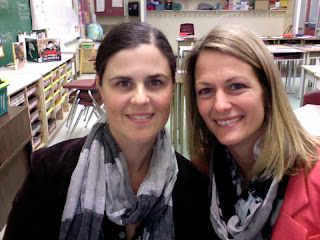We decided to begin documenting our learning journey together, as teaching job share partners and friends, in October, 2013, when we were in the midst of parent-student conferencing, because we never seem to do things in half measures. This photo was taken because we thought it was funny how similar we are. Without planning, we each wore a scarf, jacket, and exactly the same pants and flats!
We have been sharing a class since returning from maternity leave with our oldest children (we have six between us). Each of us brings different strengths to the class, and yet our philosophy of education and our view of child development and relationships is very similar.
We believe in pushing ourselves to try the current ideas and ways of teaching because we do not like being stuck in a rut. It is because of this that we decided, after a particularly stimulating professional development workshop, to embark upon becoming more tech savvy as people and teachers.
Both of us purchased our own iPads and a shared projector for our exclusive classroom use to complement the ten iPads that our school had at the time. Although it is possible to use iPads in the classroom without a projector or multiple iPads for student use, we felt that it was necessary for meaningful learning. We can model how to use apps, project individual student work on iPads for class sharing, view websites and on line videos for content areas and current events.
Since beginning this journey our school, with grants and PAC fundraising, has purchased 30 iPads and 25 iPad minis, which has increased our opportunities to learn and create with iPads.
Together we have also begun the
Mind Up program from the
Hawn Foundation, which aims to give children the tools to calm themselves so optimal learning may occur. The lessons in the program give them the ability to engage in mindful breathing, and knowledge of how their brain functions so they understand the science behind what they are doing when they practice mindful breathing.
We have also made a commitment to be mindful of our environmental impact as teachers. Schools can create a great deal of waste, and consume a great deal of energy. We strive to reduce the amount of photocopying we do and reduce the amount of paper our students consume. We have found iPads to be very useful with this goal, as students can do things like taking screen shots of webpages to highlight and take notes, rather than photocopying for student use. Many of our students have joined our Eco Team, which is working to promote energy savings and waste reduction. This year our class is also part of a gardening program which has been headed by
Ian Lai of the Terra Nova Sharing Farm.
Join us as we share our learning journey…
























